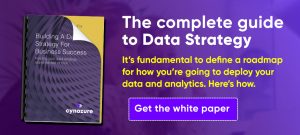Data Strategy
Data is a fundamental part of our everyday lives. Many businesses have been fast to jump on the data bandwagon, but it’s fundamental to first establish a vision and roadmap for your data.
Read our white paper to see how to implement and optimise the right data strategy framework for your business.

Almost 40% of CEOs plan to invest in data over the next three years, with 70% expecting this investment to have a large impact on their bottom line.
Data use is now something of a sprint to the finish. Every day, we generate more than 2.5 quintillion bytes of data. This can be used to generate insights, make more informed business decisions, and drive efficiency across every organisation.
It’s up to you to make the most of this opportunity. Certainly, building a data strategy is an important first step in moving the agenda forward. This provides you with a framework to generate business value from data and analytics.

Data Strategy Framework
Your data and analytics should focus on solving real business use cases, so that the rest of the data strategy is tailored to what you need. On a higher level, you should envision how your organisation will transform over this transition. Certainly, you need to set out who is responsible for translating data across the business.
This is often in the form of a Chief Data Officer. Likewise, you need to set out your methodologies to foster agile, responsive, and innovative teams. On the other hand, the data strategy framework is where you define your data governance practices, ensuring your data is secured and managed.
This is more important than ever, considering recent developments with GDPR and the ICO watchdog. Finally, the roadmap ties all this together in a time horizon. This step defines how you want to deploy your data, and when you want to reach your targets by.
Download our complete guide to building a Data Strategy, including our proven methodologies and data strategy framework for business success.








